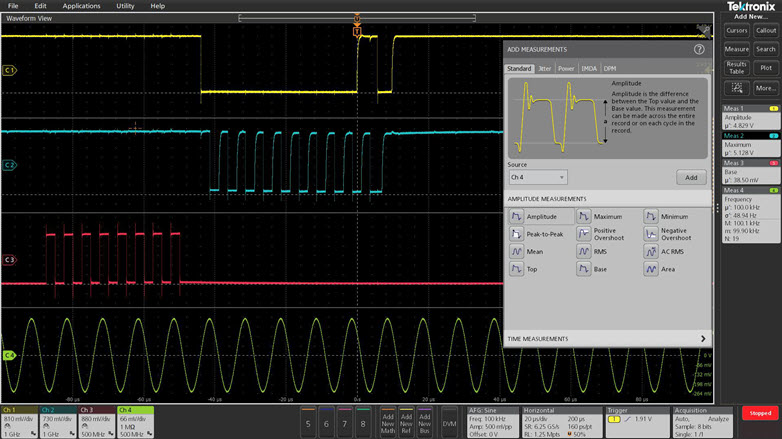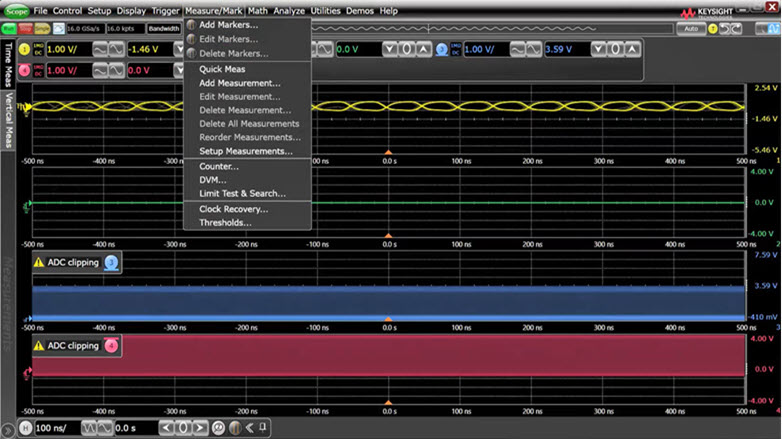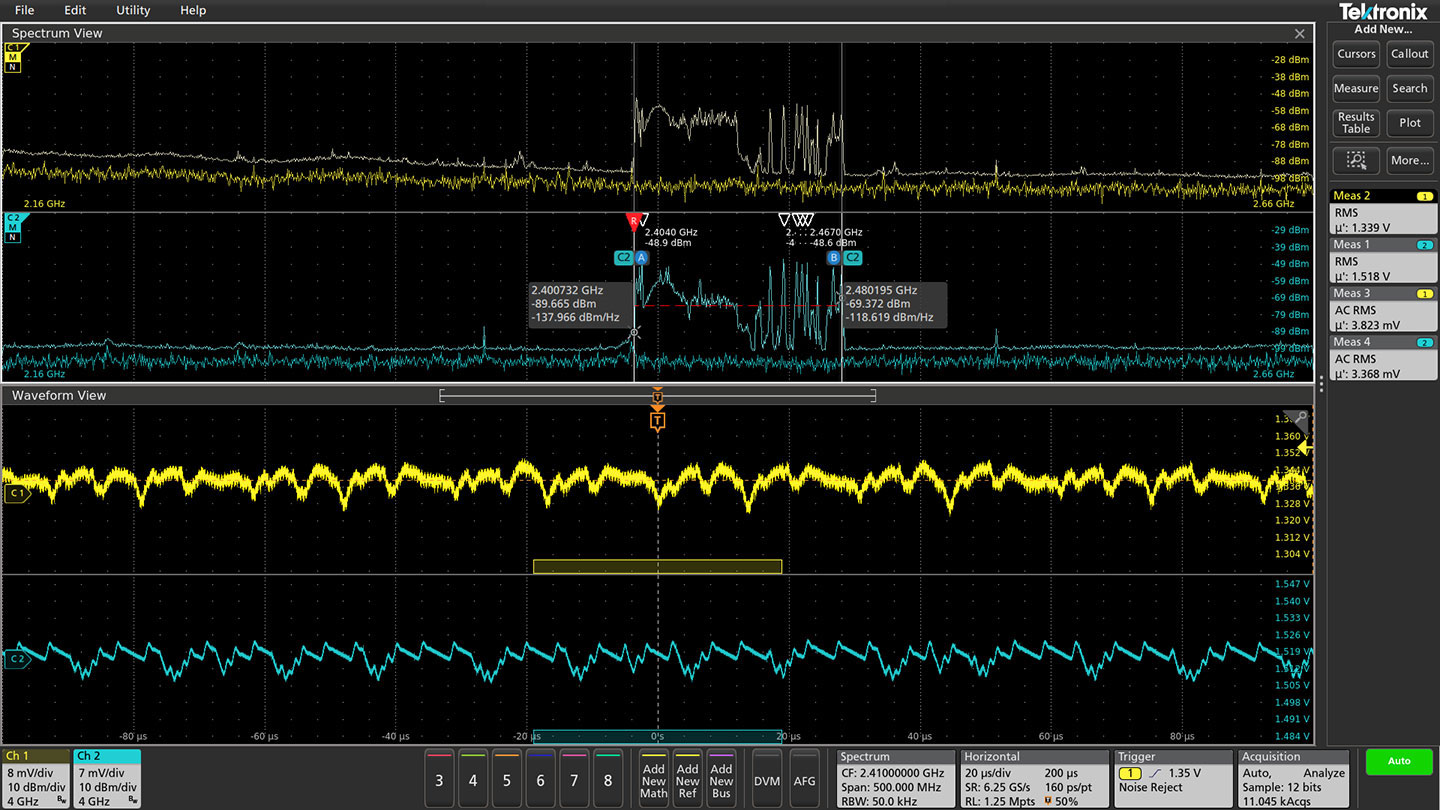

The Tektronix 5 Series MSO really changed the professional oscilloscope playing field with its large high-definition display, 6 and 8 channel models paired with an intuitive user interface that was designed from the ground up to incorporate touch interactions (pinch zoom, double tap, etc). The 6 Series incorporated these same features with higher bandwidth and improved performance.
Keysight recently released their MXR Series oscilloscopes that appear to have some similar characteristics at first glance. I rented a new MXR and compared it to our 5 and 6 Series MSOs. And while I found some similarities, I found a number of critical differences that I group into four areas:
USABILITY
Usability is an important consideration. Especially if you are a frequent user of an oscilloscope. Today’s instruments can be placed in labs, cubicles, or in our WFH environment -- occupying a place in the den, garage, or kitchen. In each of these cases, consideration should be given to the audible noise that these new oscilloscopes produce. When comparing the MXR Series to the 5 Series, it was amazing how much quieter and less intrusive the 5 Series is – the fans are so quiet that I never actually thought about them! The audible noise of the MXR fans made an immediate impression on me; this audible noise was one of the first things that I noticed when turning the MXR on and could play a factor with continual use in some of the home or cubicles we use our scopes in.
Another usability consideration is in the way one interacts with an oscilloscope. Today’s instruments, like the Tektronix 5 and 6 Series MSOs, leverage a combination of physical knobs and interacting with the display using a mouse or touchscreen. When spending time on the MXR Series, it was interesting to see how the interface was based on the 7-year-old Infinium software initially designed for mouse and keyboard usage. The ability to pinch and zoom on waveforms was limited and I missed the "measurement badges” that display measurement results and statistics on the 5 Series. Also, with enhancements being delivered 4+ times/year through firmware updates; it is far easier to focus on the measurement task at hand with a confidence in the fact the 5 Series capabilities will continue to expand over time.

Figure 1a. 4, 5 and 6 Series MSOs user interface was designed for touch from the start, and information is organized in “badges”.

Figure 1b. The interface on the Keysight MXR is based on older instruments and relies heavily on drop-down menus
ACQUISITION CAPABILITY
The acquisition capability of today’s oscilloscopes have a dramatic impact on the confidence you have in your measurement results and the designs that you are testing or validating. ASIC’s capable of delivering 12-bit ADC (analog to digital conversion) performance, like those in the 5 and 6 Series MSO, enable much cleaner signal representation.

Figure 2. Custom ASICS used in 5 and 6 Series MSOs include 12-bit ADCs, digital downconverters, and low-noise pre-amps.
The benefits are remarkable in applications like power integrity where, for example, identifying switching transients of wide bandgap devices can be difficult to accurately detect without the lowest noise, highest quantizing levels available. After my review of the MXR Series, I found the 10-bit ADC functionality to deliver lower performance on key specs like ENOB – Effective Number of Bits, SNR – Signal to Noise Ratio and Noise – baseline noise level with no signal present on the instrument, as compared to the market-leading 6 Series B MSO from Tektronix. This is a reminder to make sure your next instrument has the acquisition engine to support you now and in the future with confidence in results.
TRIGGERING AND CHANNEL FLEXIBILITY
Both the 5 & 6 Series MSO, along with the MXR Series, provide customers with up to 8 channels in a single instrument. The increased channel count works well in applications that demand increased timing visibility and cross-bus analysis. A great illustration of this is found in validating performance of popular consumer electronic or IoT devices; with 2-3 different serial interfaces alongside a Zigbee™ or Bluetooth™ radio and a switching power supply. It’s easy to see how 8 channels could be needed for a measurement system when looking at these devices.
|
|
Keysight |
Tektronix |
|
|
Trigger |
MXR Ch 1-4 |
MXR Ch 5-8 |
4/5/6 Series MSO |
|
Edge |
Yes |
Yes |
Yes – All Ch |
|
Edge Transition |
Yes |
No |
Yes – All Ch |
|
Edge then edge (time) |
Yes |
No |
Yes – All Ch |
|
Edge then edge (event) |
Yes |
No |
Yes – All Ch |
|
Pulse width |
Yes |
No |
Yes – All Ch |
|
Glitch |
Yes |
Yes |
Yes – All Ch |
|
Runt |
Yes |
No |
Yes – All Ch |
|
Timeout |
Yes |
No |
Yes – All Ch |
|
Pattern/State |
Yes |
No |
Yes – All Ch |
|
Setup/Hold |
Yes |
No |
Yes – All Ch |
|
Window |
Yes |
No |
Yes – All Ch |
|
Generic Protocol |
Yes |
Yes |
Yes – All Ch |
|
Burst |
Yes |
No |
Yes – All Ch |
|
Nth Edge |
Yes |
Yes |
Yes – All Ch |
|
OR’d Edges |
Yes |
No |
Yes – All Ch |
|
Visual/Zone Trigger |
Yes |
Yes |
Yes – All Ch |
|
Measurement Limit |
Yes |
Yes |
Yes – All Ch |
Table 1. 4, 5 and 6 Series MSOs support these triggers on all channels. Some triggers are not supported on channels 5 through 8 on the Keysight MXR.
However, not all 8-channel oscilloscopes are the same. When comparing the usefulness of those additional channels; I learned that the MXR Series’ trigger system is not equally capable on all channels. The 5 Series MSO has the ability to set up a pulse width trigger on channel 1 OR channel 8, for example. Yet the MXR would restrict the use of that trigger to just channels 1-4. In addition, on the 5/6 Series MSO, all 8 channels can acquire up to 3 different signal types seamlessly: whether it’s the Bluetooth™ signal on an RF input, the I2C bus protocol on a logic input or harmonic output of a switching power supply on the traditional analog channel.
INTEGRATED SPECTRUM ANALYSIS
Both the 5 Series MSO and MXR provide some level of analysis of analog, RF and digital domains. When comparing these new multi-domain oscilloscope offerings, I found that the Keysight MXR had a limited ability to accomplish much more than simply seeing the spectrum or the analog waveform displayed. For example, on the 5 Series; the RF view includes markers on peak RF power and specific measurement annotations for frequency, magnitude and phase. In addition, unlike the MXR, the 5 Series MSO has built-in individual controls for span, center frequency and resolution bandwidth and the flexibility to view both time and frequency domain all channels on the instrument at the same time. That is what integrated spectrum analysis should be, as demonstrated on the 5 Series MSO.

Figure 3: The 4, 5 and 6 Series MSOs offer Spectrum View -- multi-channel spectrum analysis, synchronized with time domain waveforms.
CONCLUSION
After my time with this MXR Series instrument, I’m convinced there are advantages engineers will appreciate when using the 5/6 Series MSO in these 4 areas: Usability, Acquisition Capability, Triggering and Channel Flexibility, and Integrated Spectrum Analysis. My advice is, when planning to add an oscilloscope to your bench, take the time to do research beyond traditional banner specs like bandwidth and sample rate to ensure you get the best instrument for your needs.


